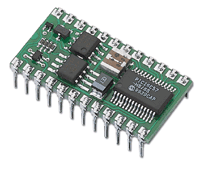What is a Basic Stamp?
A Basic Stamp is a small PCB with the size of a stamp (that's the Stamp in Basic Stamp) with on it in SMD components a capacitor,
a 5V voltageregulator, interface, an EEPROM, a resonator and a PIC within it a Basic interpreter programmed.
A Basic Stamp has 16 in/outputs (like the PIC 16F628) or on a more expensive version 32x I/O.
It works really super, but is 10x expensiver then a PIC with the same (or more) capacity.
On the PCB are (dependent from the type) minimum 24 pins in DIL format (see photo), so that the Basic Stamp fits in a normal IC socket.
When you program the Basic Stamp the Basic program comes not in the PIC (here's the Basic interpreter) but in the EEPROM.
The editor (with color syntax) where you write your Basic programs in, is to download for free from the site from Parallax.
For a Basic Stamp is no programmer necessary, you connect it directly on the (serial) COM port from your PC or laptop,
as soon as the Basic program is stored in the EEPROM, you can disconnect the connection between PC and the Basic Stamp.
A Basic Stamp is expensive, so if there are a lot of projects with a µC in it,
it's better to buy the Basic compiler from Les Johnson and work direct with PIC's,
but for beginners is a Basic Stamp ideal, in a few minutes you can write a working program.
 |
|
Basic Stamp:
+ Easy language, fast to learn
+ Ideal for beginners with micro-controllers
+ Direct connection to PC or laptop
+ No programmer necessary
+ No compiler needed (free editor)
- Expensive to buy
- Relative slow to a PIC
|
Nevertheless: a bought Basic Stamp is ever useful, but if in your electronic circuit is something terrible wrong and blow up the Stamp,
you've lost something very expensive and with a PIC handles it only for a few dollar.
